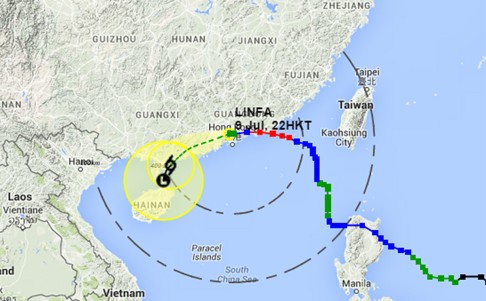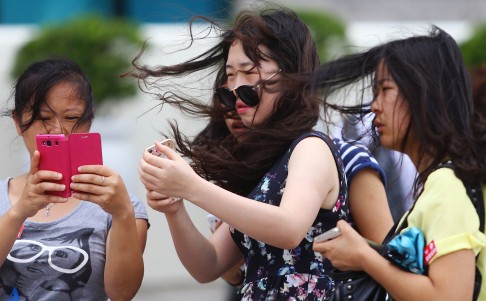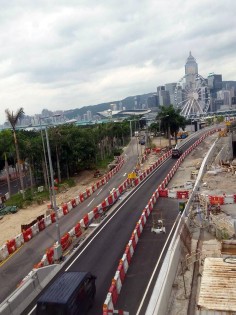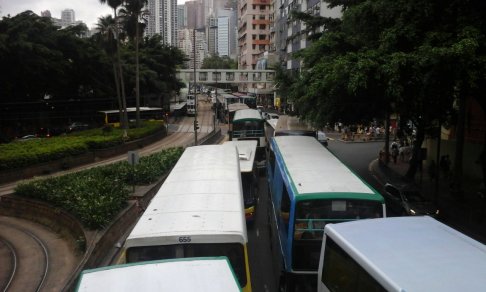
Update | Hong Kong Observatory lowers storm signal to T3 as Linfa weakens after making landfall in Guangdong
The Hong Kong Observatory replaced the typhoon No 8 signal with the strong wind signal No 3 on Thursday night, as tropical storm Linfa weakened significantly after making landfall in Guangdong.
The Hong Kong Observatory replaced the typhoon No 8 signal with the strong wind signal No 3 at 10.10pm on Thursday night, after Typhoon Linfa was downgraded to a severe tropical storm and after it made landfall in eastern Guangdong.
Tropical storm Linfa weakened rapidly as passed over rural Guangdong on Thursday night, the Hong Kong Observatory said on its website.
The Observatory raised the T8 signal at 4.40pm today as Typhoon Linfa approached after making steady landfall in the eastern Guangdong city of Lufeng.

However, as the area of gale force winds associated with Linfa continued to decrease significantly, the Observatory said it would consider lowering the storm signal.
“When the gales of Linfa pose no more threat to Hong Kong, the Observatory will consider replacing the No 8 signal by the strong wind signal No 3”, the HKO said.
By 11pm, Linfa was estimated to be about 60km northwest of Hong Kong and was forecast to move west or west-southwest at about 22km/h towards the Pearl River estuary and western Guangdong.

"There will be frequent heavy squally showers and swells," she added.
READ MORE: Hong Kong's history of deadly typhoons, and how the city stands up to them
The spokeswoman said that even though the storm showed signs of weakening, its intensity was not expected to change rapidly.

As the storm edged closer to the city, kindergarten classes and schools were suspended.

MTR stations were jam packed this afternoon as workers rushed home before the T8 signal was hoisted.
By 5.30pm, the MTR reported several disruptions to services along the West Rail Line and Tung Chung Line due to overcrowding, as people left work early after the signal was hoisted.

Frentee Ji, a 23-year old student who was out for dinner got caught in the MTR crowds at Kowloon Tong.
"I was out at five when the typhoon signal was hoisted," Ji said. "All the shops at Festival Walk were closed and I got stuck here for almost twenty minutes and cannot get on a train."


In Admiralty station, Tsuen Wan-bound passengers needed to wait for five trains before being able to board, while Hong Kong MTR station was also completely blocked, with escalators switched off.

Buses were also stuck in jams, with Mr Chan, a courier, calling the traffic "utter chaos".
"I walked all the way [to Canal Road West] from Wan Chai as I couldn't get on the bus. And the MTR is full. I am waiting for my bus back to Yuen Long," he said.

The storm approaches as China's volatile stock market entered a second day of uncertainty, with the Shanghai Index and Hang Seng Index opening at a loss in the morning before recovering later in the session. A signal 8 would mean the closure of the Hong Kong Stock Exchange.
The Hong Kong Stock Exchange said there would be no after-hours futures trading today and if the typhoon signal No 8 is still in place by noon on Friday, trading on the Hang Seng would be halted.
At 3pm on Thursday, the Education Bureau released an announcement suspending classes of all schoold and urging educators to "implement contingency measures to ensure the safety of students".

The Social Welfare Department also announced that all child care centres, elderly services centres and day rehabilitation units, including sheltered workshops and day activity centres, would be closed.

From 7pm tonight until 6am, 520 flights to and from Chek Lap Kok will be rescheduled due to Typhoon Linfa.
An Airport Authority spokeswoman urged passengers to check before travelling to the airport and said: “As the typhoon is approaching, we expect flight operations to be affected. We will implement a flight rescheduling control system from 7pm-6am."

Scheduled flights will not take off or depart as planned while Chek Lap Kok staff work to minimise the stormy weather impacting the airport.
The spokeswoman added that the rescheduling of flights did not necessarily mean cancellations.
Services of five First Ferry routes stopped early on Thursday, between 2.50pm and 4.20pm. These routes travel between Cheung Chau and Lantau, as well as between Peng Chau and Lantau.

The Ngong Ping 360 cable car system, a tourist attraction on Lantau, was also closed due to deteriorating weather, while red flags were raised on at 19 government-managed beaches due to big waves.
Typhoon Linfa made landfall at 12.15pm local time in Lufeng city, in the southeastern province of Guangdong, China’s National Meteorological Centre said.
Torrential rain has flooded several main roads in Shantou city, with fallen trees lining empty streets, reported local newspaper, Nanfang Daily.
But a stronger, more powerful Typhoon Chan-hom is following closely behind Linfa, and is expected to strengthen into a super typhoon when it reaches the southeastern province of Fujian and neighbouring Zhejiang province early on Friday morning.
Local transportation between several coastal cities have been affected. Chinese authorities have suspended passenger trains running along the eastern coast between Xiamen and Shenzhen, and will continue to do so on Friday and Saturday, according to state media reports.
Several domestic flights flying in and out from Shanghai Pudong International Airport and Fuzhou Airport have been cancelled due to the severe weather conditions.
Fujian has evacuated nearly 10,000 people, and suspended ferry services between Fujian and Taiwan.
This is the third tropical storm named Linfa to hit the northwestern Pacific Ocean this century. The name means "lotus flower" in English and was submitted by Macau to the Regional Specialised Meteorological Centre in Tokyo.
Allen Au Yeung and Frank Feng contributed reporting.
